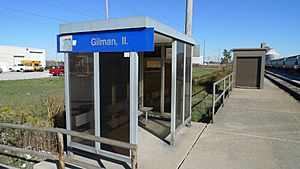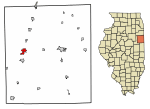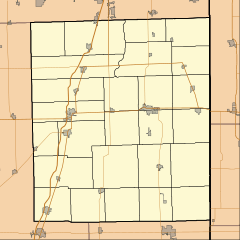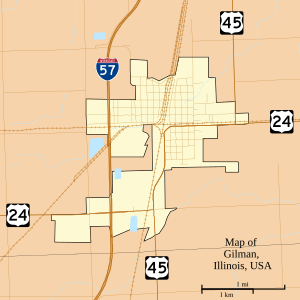Gilman, Illinois facts for kids
Quick facts for kids
Gilman, Illinois
|
|
|---|---|

Amtrak station in Gilman
|
|

Location of Gilman in Iroquois County, Illinois
|
|
| Country | |
| State | |
| County | Iroquois |
| Township | Douglas |
| Area | |
| • Total | 2.45 sq mi (6.35 km2) |
| • Land | 2.43 sq mi (6.30 km2) |
| • Water | 0.02 sq mi (0.05 km2) |
| Elevation | 650 ft (198 m) |
| Population
(2020)
|
|
| • Total | 1,738 |
| • Density | 714.34/sq mi (275.77/km2) |
| ZIP code |
60938
|
| Area code(s) | 815, 779 |
| FIPS code | 17-29275 |
Gilman is a small city located in Iroquois County, Illinois, in the United States. It's part of Douglas Township. In 2020, about 1,738 people lived there. Gilman is known as "The City of the Crossroads" because three important highways meet there.
Contents
Where is Gilman Located?
Gilman is in the western part of Iroquois County, Illinois. It's special because three major roads cross paths here: Interstate 57, U.S. Route 24, and U.S. Route 45. This makes it a busy spot for travelers.
You can also get to Gilman by train! Amtrak, which is the national passenger train service, has a station in Gilman.
Gilman is about 13 miles (21 km) west of Watseka, Illinois, which is the main town of Iroquois County. It's also 49 miles (79 km) north of Champaign, Illinois, and about 87 miles (140 km) south of the big city of Chicago.
The city covers a total area of about 2.45 square miles (6.35 square kilometers). Most of this area is land, with a tiny bit of water.
The Story of Gilman: A Look Back
How Gilman Began
Gilman was first planned out in the fall of 1857. The land belonged to a few people, including E.D. Hundley and Judge John Chamberlain. Three Methodist ministers also owned some land.
Judge Chamberlain was very important in helping Gilman grow in its early days. He was a lawyer and had served in the New York Legislature. He moved to Iroquois County in 1853 and became a judge.
The town of Gilman was started where two important railroads were going to cross. These were the Peoria and Oquawka Railroad (later called the Toledo, Peoria and Western Railway) and the Illinois Central Railroad.
The chief engineer of the Peoria and Oquawka Railroad, Octave Chanute, helped set up a train station in Gilman. In return, his company received half of the land lots in the new town. This was a common way for railroads to help new towns grow.
People wanted to name the town "Douglas" after a famous Illinois senator, Stephen Douglas. But the company that had the right to name the town chose to honor Samuel Gilman, one of their directors.
Gilman's Original Layout
The way Gilman was designed was similar to other towns built by the Peoria and Oquawka Railroad. It had a special "Depot Ground" which was a wide area of land owned by the railroad where the tracks ran through town.
The streets running east-west were given numbers, like 6th Street down to 2nd Street. The north-south streets had unique local names, such as Chamberlain, Thomas, and Douglas.
Gilman was planned to be a very large town, with 73 blocks and many lots. However, unlike many towns, Gilman didn't have one main business area. It was spread out, making it hard to find a single "center" of town.
Early Days in Gilman
The first person to build a house in Gilman was W. P. Gardner in the fall of 1857. Soon after, James Wright built a house. A big, three-story hotel was also built, costing $4,000.
The first big event in Gilman was a dance party held at the hotel on February 22, 1858. This celebrated George Washington's birthday.
The first store in Gilman that sold a full range of goods was opened by D. Harwood. The first train arrived in Gilman on September 21, 1857. This train took local people to the State Fair in Peoria, Illinois. Its arrival marked the beginning of fast growth for the new town.
The Illinois Central Railroad started running trains through Gilman in 1858. By 1860, the first school was built. By 1865, Gilman had 31 buildings. Gilman officially became an organized town in 1867.
Gilman's Continued Growth
By the late 1860s, Gilman had two important railroads. One linked St. Louis and Chicago, and the other ran across Illinois from the Mississippi River to Indiana. Gilman became a busy place where people and goods were moved from one train line to another.
In 1870, a local newspaper called the Gilman Star started publishing. The population of Gilman reached 761 people in 1870. In September 1871, a third railroad, the Gilman, Clinton and Springfield Railroad, opened.
On July 5, 1883, a large fire caused a lot of damage in the town. In 1898, an electric power plant was built, bringing electricity to Gilman.
Gilman continued to grow in the 1900s. By 1920, its population was 1,443. In the 1920s, new "hard roads" (paved roads) were built. One became U.S. Route 24, and another became Interstate 57 in the 1970s. These highways helped Gilman stay connected and continue to thrive.
Who Lives in Gilman?
| Historical population | |||
|---|---|---|---|
| Census | Pop. | %± | |
| 1880 | 1,299 | — | |
| 1890 | 1,112 | −14.4% | |
| 1900 | 1,441 | 29.6% | |
| 1910 | 1,305 | −9.4% | |
| 1920 | 1,448 | 11.0% | |
| 1930 | 1,620 | 11.9% | |
| 1940 | 1,554 | −4.1% | |
| 1950 | 1,602 | 3.1% | |
| 1960 | 1,704 | 6.4% | |
| 1970 | 1,786 | 4.8% | |
| 1980 | 1,913 | 7.1% | |
| 1990 | 1,816 | −5.1% | |
| 2000 | 1,793 | −1.3% | |
| 2010 | 1,814 | 1.2% | |
| 2020 | 1,738 | −4.2% | |
| U.S. Decennial Census | |||
According to the 2020 United States census, 1,738 people lived in Gilman. There were 688 households, and 448 families. The population density was about 708 people per square mile (275 per square kilometer).
Most of the people living in Gilman are White. About 20% of the population is Hispanic or Latino.
In terms of age, about 22.6% of the people were under 18 years old. About 20.9% were 65 years or older. The average age in Gilman was 40.6 years.
The average income for a household in Gilman was $56,719. For families, the average income was $69,333.
Local News in Gilman
The Gilman Star is a weekly newspaper that started in 1869. It shares news and information with people in the western part of Iroquois County.
Famous People from Gilman
- Frank Griffith – He was a baseball pitcher who played for teams like the Chicago Colts and Cleveland Spiders.
- Harry W. Starr – He served as an Illinois state senator.
- Franklin Underwood – He was a songwriter and a jazz pianist.
See also
 In Spanish: Gilman (Illinois) para niños
In Spanish: Gilman (Illinois) para niños




